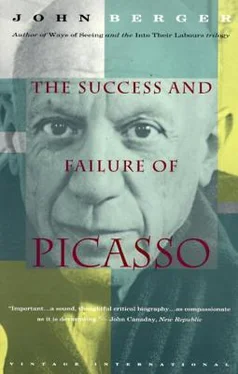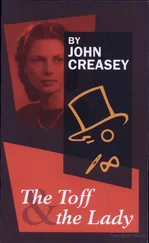
107 Picasso. Nude and Old Clown. 21 December 1953
To hide himself and at the same time to mock himself he puts on a mask. The mask emphasizes that whereas all her pleasure in physical being and in sex is natural, his, because he is old, has become obscene. Next to the young woman is an old one. In another drawing the young and the old women sit side by side. Picasso is confessing his horror at the fact that the body ages and the imagination does not. When the whole energy of life has been found in the form of resilience of a body — how is it possible to endure the continuing need for that consoling energy when the form begins to collapse?

108 Picasso. Young Woman and Old Man with Mask. 23 December 1953
He begins to envy the monkey — the monkey who so early in Picasso’s work was a symbol of freedom. He envies it because the young woman plays with it. But, more profoundly, he envies it because, unselfconscious, it pursues its desires without any sense of absurdity: on the contrary, with a complete sense of absorption which then, despite the ugliness of its body, compels the young woman to delight in it.
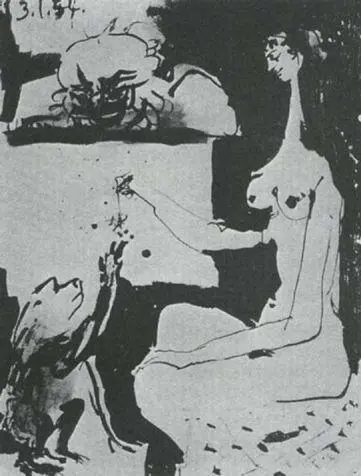
109 Picasso. Young Woman and Monkey. 3 January 1954
He returns to the idea of the mask, this time seeking comfort from the conceit that it is his old age which is the mask: and that behind it he is as young as ever. A young Cupid holds the mask in front of him. It represents both the old man’s face and his genitals: a pun which Goya used in some of his etchings and which Picasso surely remembered, but also a lonely, nostalgic variation on the theme of that composite lover’s head whose sweet smile was once all sexual pleasure.
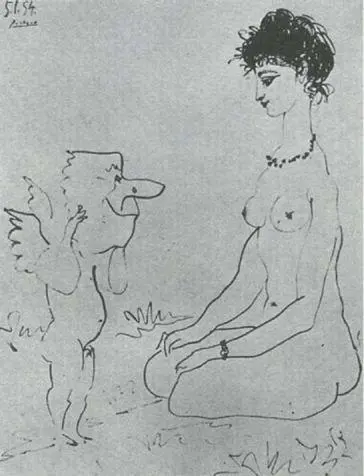
110 Picasso. Young Woman and Cupid with Mask. 5 January 1954
The Cupid, with the old man’s face and organ, courts her.
The race, the panting begins. Again the absurdity, the slavery of the situation haunts Picasso.
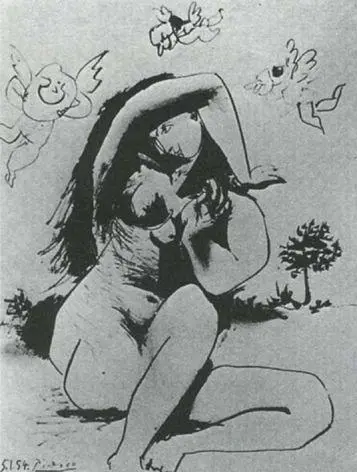
111 Picasso. Young Woman with Cupids. 5 January 1954
He draws a monkey, like a jockey, riding a horse. Then a woman, like Godiva, riding a toy horse. Later, in a world where everything is soiled, the monkey jerks himself up and down on a donkey’s back whilst a clown and a girl acrobat gaze as though sadly accepting as a truth such pointless slavery to sex.

112 Picasso. Girl, Clown, Donkey, and Monkey. 10 January 1954
To escape from the slavery Picasso thinks again of the pleasures. Summoning up the acrobats of his youth, he turns their ease into a metaphor of free enjoyment.
The memory of such happiness rides him on remorselessly.
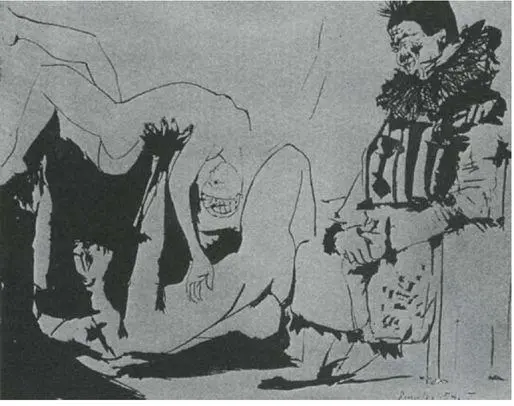
113 Picasso. Old Clown and Couple. 10 January 1954
Now he grasps at that shared subjectivity which is unique to sex and to which he had dedicated so many paintings. By the logic of this sharing she will wear his mask — the old man’s crumpled one — and he will wear her mask, eye open and fringed with lashes. Here, if the picture could become reality (and metaphorically it could), is true happiness. The horror is that the monkey remains. He sits there behind them and looks away because such sentimental illusions are of no interest to him. They have no substance and no weight.
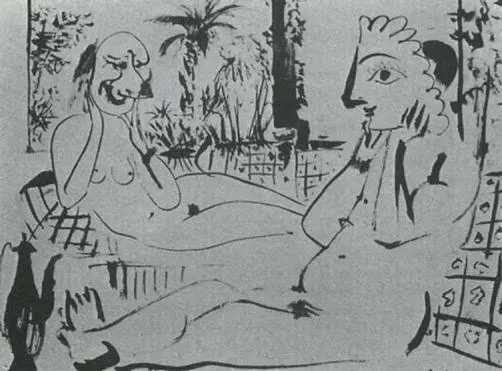
114 Picasso. Couple with Masks. 24 January 1954
On the next day, the 25th of January, 1954, Picasso, all his imagination now roused, dismisses the monkey and pursues the logic of his fantasy further. As the masks are swapped, they can also be transformed. He wears the mask of the young girl representing her almost as she is. She wears his mask, but instead of representing him as an obscene old man, it has become the mask of a virile young god. And so they play a charade (a charade that is played in many hotel bedrooms every night). Yet at the same time the prodigy in Picasso, the duende that possesses him, insists upon his telling the truth. He draws himself playing the charade so earnestly that he looks absurd. And he draws her kneeling indulgently so as to be on his level, playing as with a child to keep him happy.

115 Picasso. Old Man and Young Woman with Masks. 25 January 1954
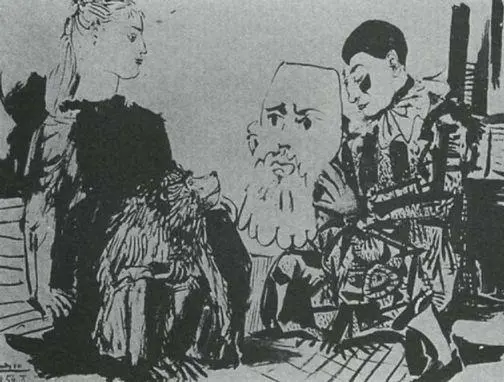
116 Picasso. Girl, Clown, Mask, and Monkey. 25 January 1954
Finally, one of the last drawings of the series shows the vanity of any attempt at escape from the absurdity of the situation. The mask — a symbol now for all that imagination can construct and subjectivity enjoy — is shown to the triumphant monkey. The monkey gazes at it blankly. The mask is held by a sad clown, whose own face is made up as though it too were a mask. But the monkey sits on its haunches beside the legs of the young woman, ready at any moment to jump into her lap and there be welcome.
Thus far one might consider this series of drawings as a very poignant and bitter lament for lost youth, and a protest against the savage sexual deprivation of old age. I think often, as I look at them, of Yeats. (Somehow, in a way that I have not yet fully understood, many connexions suggest themselves between Picasso and Yeats: the paintings of the one frequently evoke the poems of the other.)
‘Because I am mad about women
I am mad about the hills,’
Said that wild old wicked man
Who travels where God wills.
‘Not to die on the straw at home,
Those hands to close these eyes,
That is all I ask, my dear,
From the old man in the skies.
Daybreak and a candle-end
‘Kind are all your words, my dear,
Do not the rest withhold.
Who can know the year, my dear,
When an old man’s blood grows cold?
I have what no young man can have
Because he loves too much.
Читать дальше
